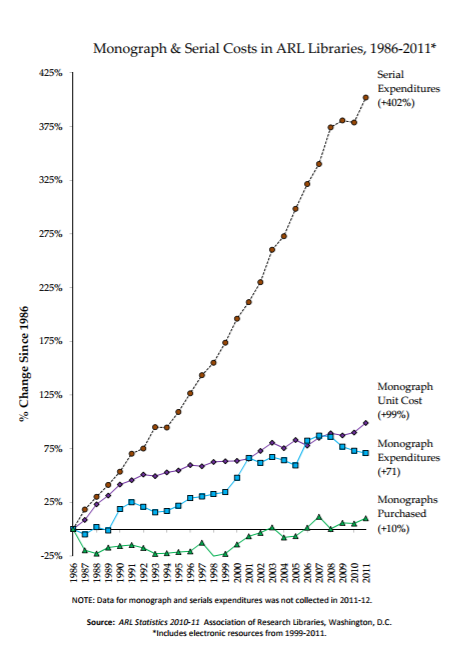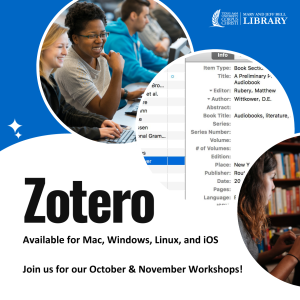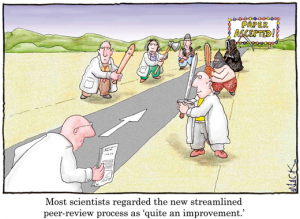What is Open Access? Open access (OA) refers to information that is digital, online, free of charge, and free of most copyright and licensing restrictions. This can include journals, books, databases, and more. Why did the open access movement begin? There are several reasons, like most things, one is due to cost. Between 1986 and 2011, serial expenditures rose 402% (see graph). For four decades, subscription prices have risen significantly faster than inflation and library budgets. Another reason for the open access movement is that of access for all. Librarians believe that information should be accessible to everyone, and if information is priced so high as to be unreasonable, the pricing model needs to change.

How does Open Access publishing work? There are two main models of Open Access: Green Open Access and Gold Open Access. Green OA is possible through repositories, where authors self-archive their work through published or pre-published versions that are available for free public use. Authors provide access to preprints or post-prints (with publisher permission) in an either an institutional or disciplinary archive such as the TAMU-CC Repository and arXiv.org. Gold OA is delivered through journals, as opposed to repositories. Gold OA publishing refers to works that are published in an open access journal and accessed via the journal or publisher’s website. Examples of Gold OA publications include PLOS (Public Library of Science) and BioMed Central.
Within Gold OA there are journals that are referred to as “hybrid journals.” Hybrid journals do not publish all their articles openly; instead, they offer authors the option of making their articles open access, if the author is willing and able to pay a fee. Fully open gold OA journals often ask for an article publishing charge, but when the article is published, it is free for all to read. Hybrid journals are still fundamentally subscription journals with an open access option for individual articles. They are not truly open journals, despite publishers using the term “gold open access” to describe their option.
To support Gold Open Access publishing, this year The Mary and Jeff Bell Library, the Division of Research and Innovation, and the Office of the Provost are proud to support Open Access (OA) through the Open Access Publication Fund. The goals of the Open Access Publication Fund include increasing access to research and scholarship produced by researchers at TAMU-CC, supporting and encouraging innovative models of scholarly publishing that take advantage of digital and networking technologies, and to help cover the costs for TAMU-CC faculty and researchers publishing materials to fully Open Access venues.
This year, for Open Access Week, the library is hosting a movie screening and panel discussion. The movie, Paywall: The Business of Scholarship, focuses on the need for OA by questioning the rationale behind the profits of academic publishers. All students, staff, and faculty who either want to learn more about Open Access, or want to discuss the advantages and disadvantages of Open Access publishing, are encouraged to attend the event.


